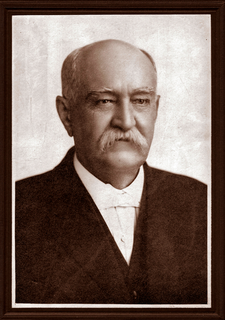
Arlington House, The Robert E. Lee Memorial, formerly named the Custis-Lee Mansion, is a Greek revival style mansion located in Arlington, Virginia, United States that was once the home of Confederate General Robert E. Lee. It overlooks the Potomac River and the National Mall in Washington, D.C. During the American Civil War, the grounds of the mansion were selected as the site of Arlington National Cemetery, in part to ensure that Lee would never again be able to return to his home. The United States has since designated the mansion as a National Memorial. Although the United States Department of the Army controls Arlington National Cemetery, the National Park Service, a component of the United States Department of the Interior, administers Arlington House.

The Judah P. Benjamin Confederate Memorial at Gamble Plantation Historic State Park, also known as the Gamble Mansion or Gamble Plantation, is a Florida State Park which is home to the Florida Division United Daughters of the Confederacy ("UDC"), located in Ellenton, Florida, on 37th Avenue East and US 301. It consists of the antebellum mansion developed by its first owner, Major Robert Gamble; a 40,000-gallon cistern to provide the household with fresh water; and 16 acres (65,000 m2) of the former sugarcane plantation. At its peak, the plantation included 3,500 acres, and Gamble likely held more than 200 slaves to work the property and process the sugarcane.

Stanton Hall, also known as Belfast, is an Antebellum Classical Revival mansion at 401 High Street in Natchez, Mississippi. Built in the 1850s, it is one of the most opulent antebellum mansions to survive in the southeastern United States. It is now operated as a historic house museum by the Pilgrimage Garden Club. The house was declared a National Historic Landmark in 1974 and a Mississippi Landmark in 1995.
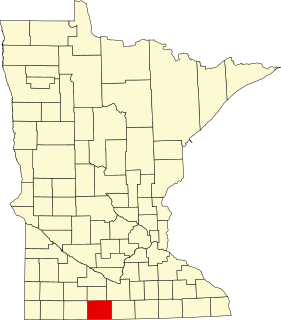
This is a list of the National Register of Historic Places listings in Martin County, Minnesota. It is intended to be a complete list of the properties and districts on the National Register of Historic Places in Martin County, Minnesota, United States. The locations of National Register properties and districts for which the latitude and longitude coordinates are included below, may be seen in an online map.

The Wyolah Plantation is a historic Southern plantation in Church Hill, Jefferson County, Mississippi. It is located off the Mississippi Highway 553.
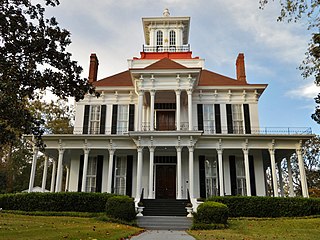
Kendall Manor is a historic mansion in Eufaula, Alabama, U.S.. It was built for planter James Turner Kendall. It was designed by architect H. George Whipple in the Italianate style. Construction began prior to the outset of the American Civil War of 1861-1865, and it was completed in 1867. It remained in the Kendall family; by the 1970s, it belonged to Dr. Kendall Eppes, Kendall's great-grandson. It has been listed on the National Register of Historic Places since January 14, 1972.

The Kiels-McNab House is a historic house located on west Washington Street in Eufaula, Alabama.

The Drewry-Mitchell-Moorer House is a historic mansion in Eufaula, Alabama, U.S.. It was built for Dr. John Drewry in 1867. It remained in the family until the 1970s, having been inherited by Drewry's daughter, Lilly Mitchell, followed by her son, A. C. Mitchell, and his daughter, Mrs. W. D. Moorer. It has been listed on the National Register of Historic Places since April 13, 1972.
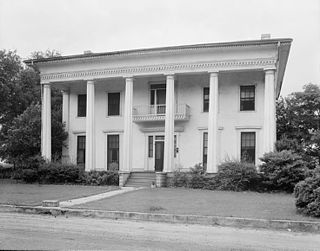
Carson Place, also known as the Cox-Mayfield-Sutley House, is a historic mansion in Tuscaloosa, Alabama, U.S..

The Guild-Verner House is a historic mansion in Tuscaloosa, Alabama, U.S..

The Dr. C.A. Thigpen House is a historic mansion in Montgomery, Alabama, U.S.. It was built for Dr. Charles A. Thigpen, a physician, circa 1898. It was designed in the classical style by architect Frank Lockwood. It has been listed on the National Register of Historic Places since December 13, 1977.
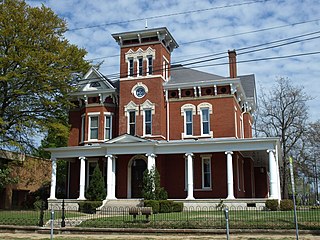
The Tyson–Maner House is a historic mansion in Montgomery, Alabama, U.S.. It was built in 1890 for Archibald Pitt Tyson, a former farmer turned real estate developer. It remained in the family until 1930, as it was inherited by his wife Ellen Nicholson Arrington in 1918 and later by their children. By the 1970s, it belonged to Carl Herbert Lancaster, an architect. It has been listed on the National Register of Historic Places since May 10, 1979.

The Bass-Perry House is a historic house on a former plantation in Seale, Alabama, U.S.

The Samuel R. Pitts Plantation, also known as the Greenwood Plantation or the William J. Benton House, is a historic house on a plantation in Pittsview, Alabama, U.S..

Hauser Mansion is a historic house in Helena, Montana, U.S.. It was built in 1885 for Governor Samuel Thomas Hauser. It was designed by the architectural firm Wallace & Thornburg. It was inherited by his daughter, Ellen Hauser Thatcher, in 1913, and subsequently donated to the Roman Catholic Bishop of Helena, John P. Carroll, followed by other bishops. From 1935 to 1969, it was used by the Sisters of Charity of Leavenworth. It was purchased by Governor Tim Babcock in 1969. It has been listed on the National Register of Historic Places since February 12, 1979.

Elmwood is a historic mansion on a former plantation located in Rutherford County near Murfreesboro, Tennessee, U.S.. It was built in the 1840s for Thomas Hord, a lawyer who owned slaves. It was designed in the Classical Revival architectural style. It has been listed on the National Register of Historic Places since October 15, 1973.

The John Holliday House, also known as Holliday Haven. is a historic mansion in Aberdeen, Mississippi, U.S.. It was built in the 1850s for John Holliday, a North Carolinian who owned a plantation west of Aberdeen called Holliday Place. It was designed in the Greek Revival architectural style. It has been listed on the National Register of Historic Places since February 22, 1988.

The Green-Evans House is a historic mansion in Lynchburg, Tennessee, U.S..

Wessyngton is a historic mansion on a former tobacco plantation in Cedar Hill, Tennessee, U.S..


